Dredge Material Placement and Behavior
| Pooles Island Placement Studies | contact: Stephen Van Ryswick ([email protected]) |
G-West Monitoring
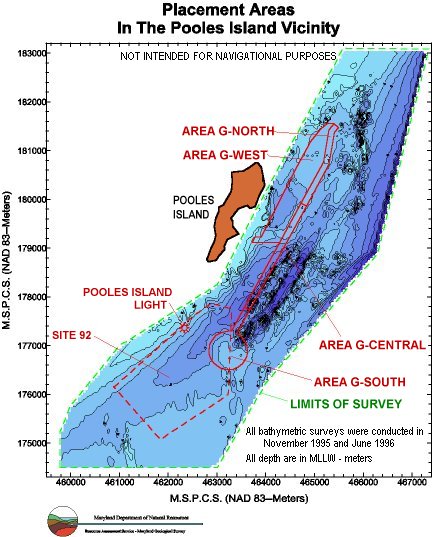 The dredging of shipping channels in the northern Chesapeake Bay is routinely required to maintain navigational access to and from the Port of Baltimore. Historically, portions of the dredged sediment have been placed overboard, on the Bay bottom, in open-water sites approved for the acceptance of those sediments. Placement of dredged sediments in open water sites ceased at the end of 2010. The accompanying map shows a number of the sites located in the vicinity of Pooles Island, the final area that was approved for the acceptance of dredged sediment. Sediments placed in the Pooles Island sites have been primarily dredged from the approach channel to the Chesapeake and Delaware Canal, located immediately to the east of the areas. Occasionally, additional sediment was derived from dredging the Eastern Extension of the Brewerton Channel.
The dredging of shipping channels in the northern Chesapeake Bay is routinely required to maintain navigational access to and from the Port of Baltimore. Historically, portions of the dredged sediment have been placed overboard, on the Bay bottom, in open-water sites approved for the acceptance of those sediments. Placement of dredged sediments in open water sites ceased at the end of 2010. The accompanying map shows a number of the sites located in the vicinity of Pooles Island, the final area that was approved for the acceptance of dredged sediment. Sediments placed in the Pooles Island sites have been primarily dredged from the approach channel to the Chesapeake and Delaware Canal, located immediately to the east of the areas. Occasionally, additional sediment was derived from dredging the Eastern Extension of the Brewerton Channel.
From the mid-1990’s through 2010 only Area G-West and Site 92 received sediment as most of the other locations shown on the map could no longer retain any placed sediment. Extensive environmental monitoring efforts have been conducted at these sites, particularly in Area G-West and Site 92. Studies covered many effects that may have resulted from the sediment placement including impacts to benthic species, fisheries, sediment turbidity, and nutrient releases. Results in every case have been within predicted, acceptable ranges. Although the boundaries of all the sites are shown on the accompanying map the southern half of G-Central and the northern portion of G-South are not approved for the acceptance of dredged sediment because of the potential for impacts to an area of prime fisheries habitat. This area is characterized by a rough bottom with high relief and can be identified on the map as the zone with closely spaced contours.
Site G-West was approved for the acceptance of dredged sediments in the early 1990's provided that the sediment could be prevented from moving into this zone of prime fisheries habitat. The following figures provide an example of the changes in bathymetry that occurred at this site as a result of the placement of sediment dredged from the Chesapeake and Delaware Canal Approach Channel.
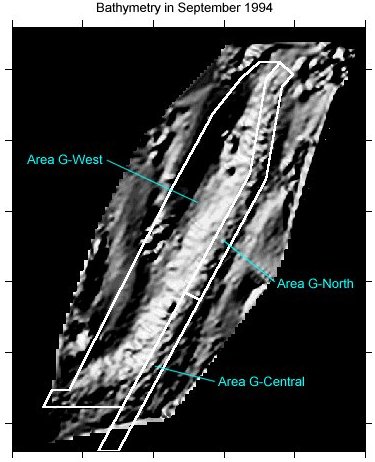 |
This figure shows an image of the bathymetric conditions in September 1994. At this point in time sediment had been placed in the narrow areas G-North and G-Central, as well as along the southern portion of G-West to create a berm. The berm crest was 4 meters below the water surface at the southern end of G-West, and between 4 and 5 meters deep in G-North and G-Central. This berm isolated a basin to the north and west that was 6 to 8 meters deep along its center. Subsequent year's sediment placement operations would occur within this isolated basin. The image shows the bottom as if sunlight were shining at a low angle from the northwest to highlight the relief.
|
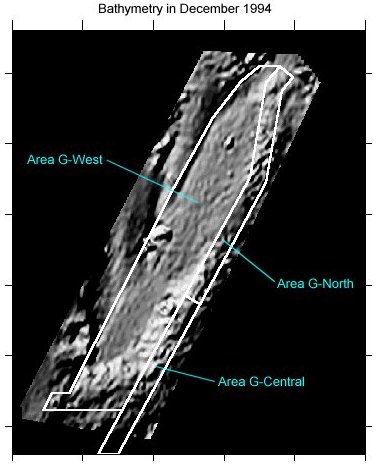 |
In the early winter of 1994 nearly 1 million cubic meters of sediment dredged from the adjacent shipping channel was placed in the center of Area G-West. The figure to the left shows an image of the bathymetric conditions in December 1994 after all placement operations had been completed. This operation reduced the basin depths to between 4 and 6 meters over much of the area, bringing the elevations up to nearly the level of the berms in Area G-North. |
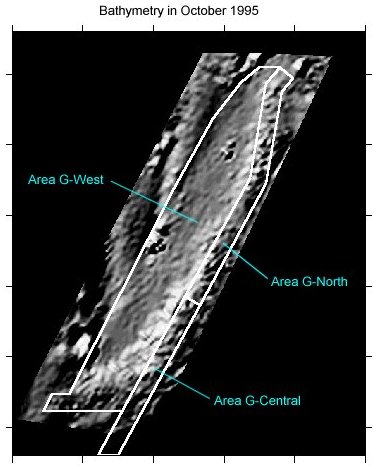 |
In October 1995, nearly 9 months following completion of the placement operation, bathymetric conditions had changed due to the consolidation and resuspension/erosion of the placed sediments. The decreasing thickness of the placed sediments had increased water depths in the center of the basin by between 0.3 and 1.25 meters. The greatest change in thickness occurred where the sediments were originally the thickest. Comparison of this image with the preceding one reveals the reappearance of the basin-like character of Area G-West. Although, the basin floor and the top of the containment berms showed less relief than in September 1994 it was judged sufficient to retain sediments placed in the center of the G-West during the winter of 1995-1996.
|
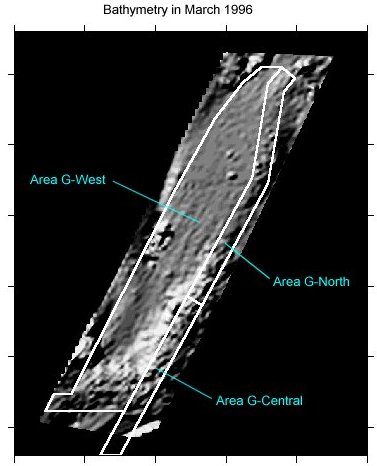 |
Over 500,000 cubic meters of sediment were dredged from the Approach Channel between 16 December 1995 and 18 March 1996 and placed in G-West. This created a new sediment layer that was between 1.0 and 1.5 meters thick over most of the site. At the end of the placement operation the sediment surface in the center of the site was nearly flush with the containment berm in G-North, but still retained the characteristics of a basin in the southern portion of the site. |
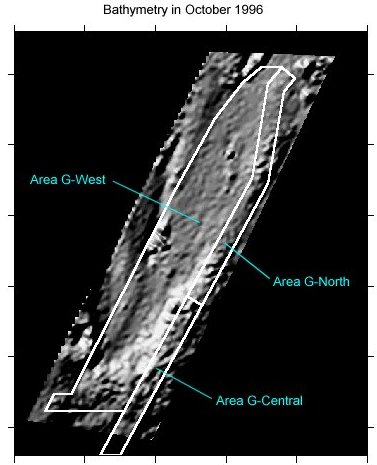 |
By October 1996 the thickness of the sediments placed in the winter of 1995/1996 had decreased by between 0.1 and 0.2 meters over much of the site, accentuating the relief with the berms in G-North and G-Central. However, the remaining capacity within the site was judged to be too little without additional elevation of the surrounding berms. Thus, for the dredging and placement operation in the winter of 1996/1997 the sediment was placed along the berms in G-North, G-Central and the southern portion of G-West to bring the elevations up to approximately 4 meter depths.
|
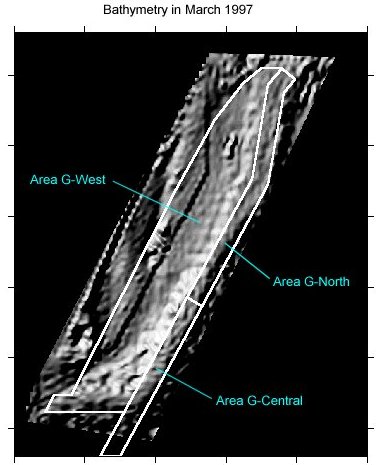 |
Sediments were placed along the lengths of the berms between 21 November 1996 and 11 February, 1997. At the end of the placement operation the conditions appeared as in the figure to the left. The top of the berm was between 3.5 and 4.0 meters below the water surface, creating a notable basin within the boundaries of G-West. It was determined that additional sediments could be placed within the site during the coming winter. Note: the dark step-like feature oriented Northeast to Southwest near the western side of G-West is an artifact of the data set.
|
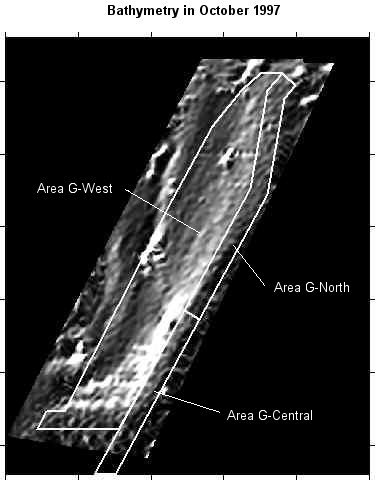 |
A survey was again conducted in October 1997 prior to the placement of sediments during the winter of 1997-1998. Conditions at the site at that time were much the same as they were during the previous March. Consolidation and erosion of the placed sediments over the six month period since March had reduced the elevation of the top of the berms by up to 0.25 meters, but sufficient relief remained to enable the placement of additional sediment. |
 |
Between 27 October and 16 December 1997, approximately 900,000 cubic meters of sediment were dredged from the adjacent channel and placed in G-West. Two separate dredging and placement methods were utilized for this work. Sediment placed in the northern portion of the site was removed from the channel using a clamshell bucket, placed in scows and towed to the area where it was released from the bottom of the scows. In the southern portion a hydraulic suction dredge was utilized to remove channel sediments which were pumped to the site. The figure to the left exhibits conditions at the end of the placement operation and shows the results of these different placement methods. In the northern portion of the site the irregular "lumps" represent mounds of sediment released from the scows while in the southern portion a smooth nearly flat bottom resulted from hydraulic placement. In the thickest sections between 1 and 1.5 meters of sediment were placed in the site bringing the elevations nearly up to the level of the surrounding berm tops. Even though relief is still apparent between the inside of the site and the southern berm top, some sediment flowed to the south of the designated area during this placement operation. It was determined that a inappropriately located pipeline resulted in the sediment movement outside the boundaries of the site. Because no comparable bathymetry existed for the area to the south, no figure can be shown which covers that area. Monitoring of conditions both within, and to the south of the site, continued through the late winter and into the summer of 1998. It was determined that no further movement of the sediment located south of Area G-West occurred over that time period. The sediment continued to consolidate in place and became reinhabited by benthic organisms. |
 |
By October 1998, nine months following placement, conditions at Area G-West appeared as to the left. Consolidation and erosion of the placed sediments within the site accentuated the relief between the center of the area and the top of the surrounding berms, and resulted in a smoothing of the irregular "lumps" in the northern portion of the site. In general, there was less than 0.5 meters of relief between the interior of the site and the top of the surrounding berms. Thus, it was determined that placement of additional sediment at G-West would not be feasible for the dredging operation conducted in the winter of 1998-1999. Since then sediments dredged from the Chesapeake and Delaware Canal Approach Channel have been placed in Site 92, the southernmost of the Pooles Island Sites. Monitoring of the placement, consolidation and erosion of the sediments placed in Site 92 continues to be conducted by the Maryland Geological Survey. |


